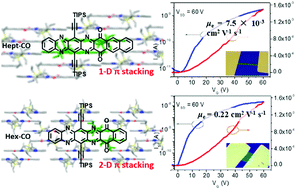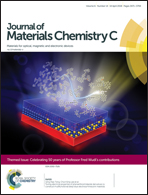Structure engineering: extending the length of azaacene derivatives through quinone bridges†
Abstract
Increasing the length of azaacene derivatives through quinone bridges is very important because these materials could have deep LUMO energy levels and larger overlapping in the solid state, which would have great applications in organic semiconducting devices. Here, two fully characterized large quinone-fused azaacenes Hex-CO and Hept-CO prepared through a novel palladium-catalyzed coupling reaction are reported. Our research clearly proved that the quinone unit can be employed as a bridge to extend the molecular conjugation length, increase the molecular overlapping, and engineer the molecular stacking mode. Hex-CO shows lamellar 2-D π-stacking modes, while Hept-CO shows 1-D π-stacking and adopts a 3-D interlocked stacking mode with the adjacent molecular layers vertical to each other. With the deep LUMO energy levels (∼−4.27 eV), Hex-CO and Hept-CO were both demonstrated to be electron-transport layers. Their charge transport properties were investigated through OFETs and theoretical calculations. Due to the different stacking modes, Hex-CO shows a higher electron mobility of 0.22 cm2 V−1 s−1 than Hept-CO (7.5 × 10−3 cm2 V−1 s−1) in a single-crystal-based OFET. Our results provide a new route for structure engineering through extending the azaacene derivatives by quinone bridges, which can be of profound significance in organic electronics.

- This article is part of the themed collection: Celebrating 50 years of Professor Fred Wudl’s contributions to the field of organic semiconductors


 Please wait while we load your content...
Please wait while we load your content...